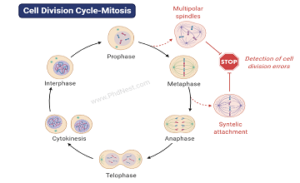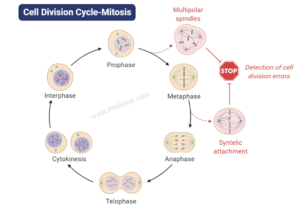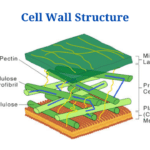Definition of Mitosis
Mitosis is a type of cell division that occurs in the body.
- Mitosis is a cell division process in which one cell divides into two genetically identical daughter cells, resulting in cell reproduction and duplication.
- The number of chromosomes is preserved in both the daughter cells.
- Mitosis is a short period of chromosome condensation, segregation, and cytoplasmic division.
- Mitosis occurs in somatic cells and is responsible for the increase of cell numbers throughout plant and animal embryogenesis and blastogenesis.
- Mitosis is surprisingly similar in all animals and plants as a process.
How to increase Brain Power – Secrets of Brain Unlocked
Mitosis Purpose (What is the purpose of Mitosis ?)
Mitosis plays an important role in both cell division and cell reproduction. The following are some of the primary implications/purposes:
- Continuous mitosis increases the number of cells in an organism, allowing it to evolve from a single cell to a complex living entity.
- Mitosis is a process in which different cells in the body, such as skin cells and red blood cells, are regularly replaced. Mitosis produces approximately 5×109 cells every day in people.
- In the starfish, mitosis is also involved in the repair and regeneration of body components.
- Mitosis is the asexual reproduction process used by many species.
Mitosis stages
Mitosis is a stage of the cell cycle that is preceded by the S phase of interphase and is usually followed by cytokinesis. Prior to the commencement of mitosis, chromosomal replication and protein synthesis essential for spindle fibre production occur.
Based on the completion of one set of activities and the commencement of the next, mitosis is split into the following phases.
-
Interphase (Transitional period)
- The cell cycle’s interphase is when the cell copies its DNA in preparation for the M phase (mitotic phase).
- Interphase is generally referred to as the most active phase of the cell cycle because the cell’s metabolism increases.
- During this phase, a variety of metabolic changes occur, which are grouped into three groupings.
The G1 phase, also known as the pre-DNA synthesis phase, is the first stage of DNA synthesis.
- It is the cell cycle’s longest phase, and it is followed by the M phase from the previous cell cycle.
- It is also known as the “resting phase” since no DNA synthesis occurs during this time.
- During the G1 phase, however, multiple cell organelles grow in size and the cell rapidly synthesises several types of RNA and proteins.
- During this phase, important activities like as the transcription of three types of RNAs, the production of regulatory proteins, enzymes essential for DNA synthesis, tubulin proteins, and other mitotic machinery occur.
DNA Synthesis Phase (S-phase)
- The replication of nuclear DNA and the production of histone proteins are both part of the S-phase. Cytoplasmic DNA replication can occur at any point during the cell cycle.
- Each chromosome has two DNA molecules and a duplicate set of genes at the end of the S phase. This stage lasts approximately 6-10 hours.
- G2-phase, also known as the post-DNA-synthesis phase
- The G2 phase is also known as the interphase’s second gap phase or resting phase.
- The synthesis of RNA and proteins necessary by the cell continues throughout this period.
- Because cell division requires a large amount of energy, the cell stores ATP in the G2.
- The cell enters the division or M-phase of the cell cycle at the end of this phase.
2. Prophase
- The emergence of thin-thread like condensing chromosomes characterises prophase, the earliest step of mitosis.
- The cell becomes spheroid during prophase, and the cytoplasm becomes more refractile, viscous, and pale.
- In the prophase, the chromosome is made up of two coiled filaments called chromatids, which are the product of DNA replication in the S phase.
- The chromatids become shorter and thicker as prophase advances, and a specific DNA-containing area called the centromere holds two sister chromatids of each chromosome together.
- Similarly, as the chromosomes approach the nuclear envelope, the nucleus’ core area becomes vacant.
- Meanwhile, two pairs of centrioles are migrating to opposing poles of the cell, encircled by microtubules spreading in all directions.
- Finally, the nucleolus gradually disintegrates during prophase, signalling the end of prophase.
- The nuclear envelope, on the other hand, does not dissolve during mitosis in some primitive plants and animals.
3. Prometaphase
- The nuclear envelope breaks dissolved, allowing spindle fibres to interact with the chromosomes, and therefore prometaphase begins.
- Because their centromeres are catching the ends of microtubules and being tugged by the captured microtubules, the chromosomes are aggressively rotated and oscillated back and forth between the spindle poles at this stage.
- The sister chromatids are connected to the spindle fibres on opposing ends by the end of prometaphase and are kept on the metaphase plate.
4. Metaphase
- The chromosomes are the shortest and thickest during metaphase.
- The sister chromatids’ centromeres occupy the equator’s plane, forming a metaphase plate, and the arms stay pointed towards the poles.
- The microtubules remain fixed and under tension as two chromatids of a chromosome repel each other.
5. Anaphase
- The anaphase begins abruptly with each chromosome splitting into sister chromatids, known as daughter chromosomes, which separate for the centromere.
- During prophase, an increase in cytosolic Ca2+ causes each centromere to divide.
- The movement of chromatids towards the pole in anaphase is caused by the shortening of microtubules.
- The centromeres remain forward during their poleward migration, giving the chromosomes their typical U, V, or J form.
- Interzonal fibres help chromosomes travel towards the pole by expanding and supporting them.
- The transport of chromosomes to the poles necessitates a total of 30 ATPs.
6. Telophase
- The telophase begins when the daughter chromosomes have completed their movement to the poles.
- The events of prophase occur in reverse order during telophase.
- To generate two daughter nuclei, a nuclear envelope reassembles around each set of chromosomes.
- During telophase, events such as the removal of the mitotic apparatus, a decrease in the viscosity of the cytoplasm, and the synthesis of RNA occur.
- At the end of telophase, the chromosomes return their long, slender, stretched form, and the nucleolus reappears.
7. Cytokinesis
- Cytokinesis is the division of cytoplasm followed by mitosis, which results in the development of two daughter cells.
- Cytokinesis normally starts in anaphase and lasts through telophase and interphase.
- In animals, cytokinesis is characterised by constriction and the creation of furrows.
- The constriction of the plasma membrane during anaphase is the earliest symptom of cleavage in animal cells.
- The constriction always occurs in the plane of the metaphase plate, perpendicular to the mitotic spindle apparatus’s long axis.
- From the outer to the inside, the constriction grows deeper, and the cell eventually divides into two daughter cells.
- Plants, on the other hand, undergo cytokinesis through the creation of cell plates because constriction is impossible due to the presence of a solid cell wall.
- The Golgi apparatus line up on the equator to generate phragmoplast, which later becomes the cell plate in plants.
Mitosis has a variety of applications.
Mitosis has been used in a variety of molecular biology and biotechnology processes in the lab. Mitosis is used in a variety of ways, including:
- Cloning
- Cloning is a biotechnological procedure for making identical duplicates of cells or DNA fragments.
- The process of mitosis is employed in cloning to increase the number of organisms, which is subsequently used in a variety of biological tests such as fingerprinting.
- Tissue culture
Tissue culture is a method of preserving tissue. The process of growing tissues or cells outside of an organism’s body in a liquid, semi-solid, or solid growth medium is known as tissue culture.
Tissue culture is based on the mitotic process, in which a cell divides into several tissues. Tissue culture can also lead to organ culture in a variety of organisms.
- Regeneration of stem cells
Stem cells are a type of cell that can be programmed to become other types of cells in the body. Mitosis is a process that stem cells can go through to regenerate and repair sick or damaged tissues in people.
Click Here for Complete Biology Notes
Mitosis Citations
- Rastogi SC (2006). Cell and Molecular Biology. Second Edition. New Age International.
- http://www.authorstream.com/Presentation/aSGuest108184-1131832-application-of-mitosis/
- https://www.siyavula.com/read/science/grade-10-lifesciences/cell-division/03-cell-division-03
- https://www.creativebiomart.net/researcharea-cytokinesis-proteins_923.htm
- https://www.quora.com/Do-diploid-cells-undergo-mitosis-to-repair-a-cell
- https://www.ncbi.nlm.nih.gov/books/NBK26934/
- https://quizlet.com/47119599/cell-division-flash-cards/
- https://quizlet.com/140602691/chapter-10-14-biology-flash-cards/
- https://quizlet.com/129430970/bio-156-lesson-7-cell-division-flash-cards/
- https://quizlet.com/108608762/cell-biology-exam-4-flash-cards/
- https://micro.magnet.fsu.edu/cells/fluorescencemitosis/prometaphasesmall.html
- https://micro.magnet.fsu.edu/cells/fluorescencemitosis/metaphasesmall.html
- https://en.wikipedia.org/wiki/Mitotic
- https://en.wikipedia.org/wiki/Cellular_mitosis
- https://en.mimi.hu/biology/interphase.html
- https://brainly.com/question/3129214
- https://answersdrive.com/what-is-the-definition-of-mitosis-for-kids-1776406
- http://www.solarnavigator.net/cloning.htm
- https://www.sparknotes.com/biology/cellreproduction/intro/section2/
- https://www.researchgate.net/publication/226475230_Replication_of_nuclear_DNA
Related Posts
- Lineweaver–Burk Plot with Example
- Cell Wall: Definition, Diagram, Structure And Functions
- Phylum Porifera: Classification, Characteristics, Examples
- Dissecting Microscope (Stereo Microscope) Definition, Principle, Uses, Parts
- Epithelial Tissue Vs Connective Tissue: Definition, 16+ Differences, Examples
- 29+ Differences Between Arteries and Veins
- 31+ Differences Between DNA and RNA (DNA vs RNA)
- Eukaryotic Cells: Definition, Parts, Structure, Examples
- Centrifugal Force: Definition, Principle, Formula, Examples
- Asexual Vs Sexual Reproduction: Overview, 18+ Differences, Examples
- Glandular Epithelium: Location, Structure, Functions, Examples
- 25+ Differences between Invertebrates and Vertebrates
- Cilia and Flagella: Definition, Structure, Functions and Diagram
- P-value: Definition, Formula, Table and Calculation
- Nucleosome Model of Chromosome

















